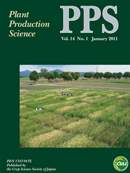Volume 14, Issue 1
Displaying 1-8 of 8 articles from this issue
- |<
- <
- 1
- >
- >|
Review
-
2011Volume 14Issue 1 Pages 1-14
Published: 2011
Released on J-STAGE: January 07, 2011
Download PDF (601K)
Crop Morphology
-
2011Volume 14Issue 1 Pages 15-21
Published: 2011
Released on J-STAGE: January 07, 2011
Download PDF (683K)
Crop Physiology
-
2011Volume 14Issue 1 Pages 22-29
Published: 2011
Released on J-STAGE: January 07, 2011
Download PDF (599K)
Agronomy & Crop Ecology
-
2011Volume 14Issue 1 Pages 30-46
Published: 2011
Released on J-STAGE: January 07, 2011
Download PDF (1848K) -
2011Volume 14Issue 1 Pages 47-55
Published: 2011
Released on J-STAGE: January 07, 2011
Download PDF (768K) -
2011Volume 14Issue 1 Pages 56-63
Published: 2011
Released on J-STAGE: January 07, 2011
Download PDF (732K) -
2011Volume 14Issue 1 Pages 64-74
Published: 2011
Released on J-STAGE: January 07, 2011
Download PDF (3755K) -
2011Volume 14Issue 1 Pages 75-85
Published: 2011
Released on J-STAGE: January 07, 2011
Download PDF (732K)
- |<
- <
- 1
- >
- >|
